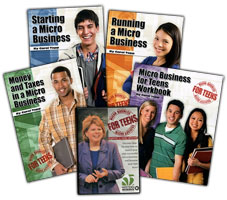Plenty of teenagers want to make money, but would rather do something more fulfilling or instructive than simply flipping burgers at Joe's Grease Bomb. Problem is, a variety of obstacles can keep them from realizing their entrepreneurial dreams—not only do they have to do homework, go to school, maintain their social lives, and sleep, teenagers aren't able to obtain business loans, and there's a whole host of bureaucratic and tax hoops to jump through.
How's a young person supposed to navigate all this? How are they even supposed to figure out what kind of business to start, and how can they go from initial idea to lucrative reality? Well, it's no cakewalk, but with the help of the materials by Carol Topp it can be a lot easier. She guides teens from the very beginning to the very end, covering both the technical aspects and the creative concerns such as advertising and marketing.
How Do These Work?
 Three books, a workbook, and a DVD walk teens through the basics and the details of starting their own micro business. As the name suggests, a "micro business" is a small one, technically one with fewer than ten employees. Micro businesses generally require little money to start up and operate, they can be owned and operated by one person, and they are flexible enough to be fit into a busy schedule. In other words, they're perfect for teenagers.
Three books, a workbook, and a DVD walk teens through the basics and the details of starting their own micro business. As the name suggests, a "micro business" is a small one, technically one with fewer than ten employees. Micro businesses generally require little money to start up and operate, they can be owned and operated by one person, and they are flexible enough to be fit into a busy schedule. In other words, they're perfect for teenagers.
Starting a Micro Business assumes readers want to start a business and aren't sure where to start. After describing the concept of micro business, Topp provides a long list of ideas for possible teen-owned micro businesses, and warns of possible scams for kids to beware of, particularly pyramid schemes and product sales. There's a chapter on pitfalls and how to avoid them, a chapter guiding readers through the writing of a business plan, advice for financing the business, important things teens need to know about particular business ideas, and a final motivational chapter.
Running a Micro Business helps young entrepreneurs with the important work of keeping a business going once they've got it off the ground. There are nine chapters covering the following topics: sales, marketing, customer service, record keeping, bookkeeping basics, using software, legal names and numbers, reducing risk, and time management. Topp discusses everything from wearing nice clothes to figuring out whether your business needs to be insured.
Less interesting as to subject matter yet probably the most important of these books is Money and Taxes in a Micro Business, in which Topp walks teens through the issues of taxes, profits, money management, ratios, whether to hire an accountant, and much more. A variety of websites are mentioned throughout the text, and important IRS tax documents are reproduced so readers can better understand their purpose and how to fill them out.
The Micro Business for Teens Workbook is a consumable text to help students simultaneously work through Starting a Micro Business and Running a Micro Business, and to plan, start, and run their business. Before using the workbook, students should watch the Starting a Micro Business - DVD which can also be watched for free on the website www.microbusinessforteens.com or YouTube; the film is an introduction to these principles and ideas. Topp leaves nothing to guesswork in this workbook, asking students to think about and record every step of the process.
Topp writes very clearly, uses graphics and lists often, and even when discussing difficult topics keeps things at a level motivated teens will have no difficulty understanding. The prospect of starting a business can be daunting, and there's certainly a lot of work involved, but with Topp to help you through each step the whole process loses much of its terror and becomes a viable prospect for kids willing to roll up their sleeves and get things done.
Our Honest Opinion
There is legitimately nothing like this out there, at least nothing that we've seen. There are economics textbooks, courses on the ideological importance of the free market system, and books for little kids about starting a lemonade stand (as Topp points out), but nothing that walks older students through each step of starting a real, operable business that will generate cashflow and give teens a crash course in entrepreneurship.
Until now. Carol Topp's tools fill exactly that void, and while the books aren't particularly riveting, they're well written, clear, and exceptionally helpful. They also aren't for everyone. Students with little interest in business, entrepreneurship, or related pursuits will probably not have the tenacity or excitement needed to get their own business off the ground, or even to make it through these materials. For those who are interested, however, the Micro Business for Teens course is indispensable.
Did you find this review helpful?